Monitoring the Whole Cycle Length Change of Cement Mortar Incorporated with SRA by CMOS Image Sensor
Abstract
1. Introduction
2. Experimental
2.1. Materials and Mortar Composition
2.2. Axial Length Change Monitoring Using CMOS Image Sensor
2.3. Curing Conditions
2.3.1. Hot–Dry Curing
2.3.2. Alternating Wet and Dry Exposure
2.4. Characterization of Liquid Evaporation and Microstructural Properties
3. Results and Discussion
3.1. Evaporation of Solutions and Mortars
3.2. Effect of SRAs on Shrinkage Properties under Dry and Hot Curing Conditions
3.3. Alternating Temperature and Humidity Conditions
3.3.1. Re-Wet Curing
3.3.2. Secondary Drying
3.4. Analysis of Macroscopic and Microscale Physical Properties
4. Conclusions
- Not only did the SRAs significantly inhibit the shrinkage of cement mortar, but the decrease in shrinkage increased as the SRA dosages increased. The addition of SRAs to mortars moderated the liquid evaporation process but only affected the water loss process as a whole and exhibited little effect on the total amount of water that could be evaporated;
- Although SRAs present certain inhibitory effects on wet swelling at different ages, this inhibition generally occurred in the early stages of aging. Owing to their “water retention” effect, the SRAs increased the Ca/Si ratio and hydration degree of cement mortars under alternating temperature and humidity conditions;
- Secondary shrinkage in cement mortar was closely related to the volume of 3–50 nm pores, but total shrinkage could be confined when CSH gel achieved a higher polymerization state by incorporating high dosages of SRAs into mortars.
Author Contributions
Funding
Conflicts of Interest
References
- Li, Y.; Bao, J.; Guo, Y. The relationship between autogenous shrinkage and pore structure of cement paste with mineral admixtures. Constr. Build. Mater. 2010, 24, 1855–1860. [Google Scholar] [CrossRef]
- Mo, L.; Deng, M.; Wang, A. Effects of MgO-based expansive additive on compensating the shrinkage of cement paste under non-wet curing conditions. Cem. Concr. Compos. 2012, 34, 377–383. [Google Scholar] [CrossRef]
- Han, J.; Jia, D.; Yan, P. Understanding the shrinkage compensating ability of type K expansive agent in concrete. Constr. Build. Mater. 2016, 116, 36–44. [Google Scholar] [CrossRef]
- Shah, S.P. Cracking behavior of concrete with shrinkage reducing admixtures and PVA fibers. Cem. Concr. Compos. 2009, 31, 699–704. [Google Scholar]
- Kawashima, S.; Shah, S.P. Early-age autogenous and drying shrinkage behavior of cellulose fiber-reinforced cementitious materials. Cem. Concr. Compos. 2011, 33, 201–208. [Google Scholar] [CrossRef]
- Zhan, P.M.; He, Z.H. Application of shrinkage reducing admixture in concrete: A review. Constr. Build. Mater. 2019, 201, 676–690. [Google Scholar] [CrossRef]
- Meddah, M.S.; Suzuki, M.; Sato, R. Influence of a combination of expansive and shrinkage-reducing admixture on autogenous deformation and self-stress of silica fume high-performance concrete. Constr. Build. Mater. 2011, 25, 239–250. [Google Scholar] [CrossRef]
- José Oliveira, M.; Ribeiro, A.B.; Branco, F.G. Combined effect of expansive and shrinkage reducing admixtures to control autogenous shrinkage in self-compacting concrete. Constr. Build. Mater. 2014, 52, 267–275. [Google Scholar] [CrossRef]
- Semianiuk, V.; Tur, V.; Herrador, M.F.; Paredes, G.M. Early age strains and self-stresses of expansive concrete members under uniaxial restraint conditions. Constr. Build. Mater. 2017, 131, 39–49. [Google Scholar] [CrossRef]
- Liwu, M.; Min, D.; Mingshu, T. Effects of calcination condition on expansion property of MgO-type expansive agent used in cement-based materials. Cem. Concr. Res. 2010, 40, 437–446. [Google Scholar]
- Wehbe, Y.; Ghahremaninezhad, A. Combined effect of shrinkage reducing admixtures (SRA) and superabsorbent polymers (SAP) on the autogenous shrinkage, hydration and properties of cementitious materials. Constr. Build. Mater. 2017, 138, 151–162. [Google Scholar] [CrossRef]
- Lura, P.; Mazzotta, G.B.; Rajabipour, F.; Weiss, J. Evaporation, settlement, temperature evolution, and development of plastic shrinkage cracks in mortars with shrinkage-reducing admixtures. In Proceedings of the International RILEM-JCI Seminar on Concrete Durability & Service Life Planning: Curing, Crack Control, Performance in Harsh Environments (Concretelife’06), Dead Sea, Israel, 14–16 March 2006. [Google Scholar]
- Lura, P.; Pease, B.; Mazzotta, G.B.; Rajabipour, F.; Weiss, W. Influence of Shrinkage-Reducing Admixtures on Development of Plastic Shrinkage Cracks. ACI Mater. J. 2007, 104, 187–194. [Google Scholar]
- Saliba, J.; Rozière, E.; Grondin, F.; Loukili, A. Influence of shrinkage-reducing admixtures on plastic and long-term shrinkage. Cem. Concr. Compos. 2011, 33, 209–217. [Google Scholar] [CrossRef]
- Leemann, A.; Nygaard, P.; Lura, P. Impact of admixtures on the plastic shrinkage cracking of self-compacting concrete. Cem. Concr. Compos. 2014, 46, 1–7. [Google Scholar] [CrossRef]
- Zhang, W.; Hama, Y.; Na, S.H. Drying shrinkage and microstructure characteristics of mortar incorporating ground granulated blast furnace slag and shrinkage reducing admixture. Constr. Build. Mater. 2015, 93, 267–277. [Google Scholar] [CrossRef]
- Pour-Ghaz, M.; Spragg, R.; Weiss, J. Moisture profiles and diffusion coefficients in mortars containing shrinkage reducing admixtures. In Proceedings of the International RILEM Conference on Use of Superabsorbent Polymers and Other New Additives in Concrete, Lyngby, Denmark, 15–18 August 2010; pp. 197–206. [Google Scholar]
- Sant, G.; Eberhardt, A.; Bentz, D.; Weiss, J. The Influence of Shrinkage-Reducing Admixtures (SRAs) on Moisture Absorption in Cementitious Materials at Early Ages. J. Mater. Civ. Eng. 2010, 22, 277–286. [Google Scholar] [CrossRef]
- Weiss, J.; Lura, P.; Rajabipour, F.; Sant, G. Performance of Shrinkage-Reducing Admixtures at Different Humidities and at Early Ages. ACI Mater. J. 2008, 105, 478–486. [Google Scholar]
- Collepardi, M.; Borsoi, A.; Collepardi, S.; Ogoumah Olagot, J.J.; Troli, R. Effects of shrinkage reducing admixture in shrinkage compensating concrete under non-wet curing conditions. Cem. Concr. Compos. 2005, 27, 704–708. [Google Scholar] [CrossRef]
- Bentz, D.P. Influence of Shrinkage-Reducing Admixtures on Early-Age Properties of Cement Pastes. J. Adv. Concr. Technol. 2006, 4, 423–429. [Google Scholar] [CrossRef][Green Version]
- Schröfl, C.; Mechtcherine, V.; Gorges, M. Relation between the molecular structure and the efficiency of superabsorbent polymers (SAP) as concrete admixture to mitigate autogenous shrinkage. Cem. Concr. Res. 2012, 42, 865–873. [Google Scholar] [CrossRef]
- Weiss, J.; Scrivener, K. The origin of early age expansions induced in cementitious materials containing shrinkage reducing admixtures. Cem. Concr. Res. 2011, 41, 218–229. [Google Scholar]
- Zuo, W.; Feng, P.; Zhong, P.; Tian, Q.; Gao, N.; Wang, Y.; Yu, C.; Miao, C. Effects of novel polymer-type shrinkage-reducing admixture on early age autogenous deformation of cement pastes. Cem. Concr. Res. 2017, 100, 413–422. [Google Scholar] [CrossRef]
- Zuo, W.; Feng, P.; Zhong, P.; Tian, Q.; Liu, J.; She, W. Effects of a novel polymer-type shrinkage-reducing admixture on early age microstructure evolution and transport properties of cement pastes. Cem. Concr. Compos. 2019, 95, 33–41. [Google Scholar] [CrossRef]
- Weiss, J. Interactions between shrinkage reducing admixtures (SRA) and cement paste’s pore solution. Cem. Concr. Res. 2008, 38, 606–615. [Google Scholar]
- Zaichenko, M.; Nazarova, A.; Marshdi, Q. Effect of expansive agent and shrinkage reducing admixture in shrinkage-compensating concrete under hot–dry curing environment. Teka Comm. Mot. Engrgetics Agric. 2014, 14, 170–178. [Google Scholar]
- Joseph Friebele, E. Fiber Bragg grating strain sensors, present and future applications in smart structures. Opt. Photonics News 1998, 9, 33–38. [Google Scholar] [CrossRef]
- Mizuno, Y.; Kawasaki, A.; Watanabe, R. Measurement of nonuniform sintering shrinkage of functionally gradient material by digital image processing. Metall. Mater. Trans. B 1995, 26, 75–79. [Google Scholar] [CrossRef]
- Yazdizadeh, Z.; Marzouk, H.; Hadianfard, M.A. Monitoring of concrete shrinkage and creep using Fiber Bragg Grating sensors. Constr. Build. Mater. 2017, 137, 505–512. [Google Scholar] [CrossRef]
- Bentz, D.P.; Snyder, K.A.; Peltz, M.A. Doubling the service life of concrete structures. II: Performance of nanoscale viscosity modifiers in mortars. Cem. Concr. Compos. 2010, 32, 187–193. [Google Scholar] [CrossRef]
- Saint, G.; Bentz, D.; Weiss, J. Capillary porosity depercolation in cement-based materials: Measurement techniques and factors which influence their interpretation. Cem. Concr. Res. 2011, 41, 854–864. [Google Scholar] [CrossRef]
- Juenger, M.C.G.; Jennings, H.M. Examining the relationship between the microstructure of calcium silicate hydrate and drying shrinkage of cement pastes. Cem. Concr. Res. 2002, 32, 289–296. [Google Scholar] [CrossRef]
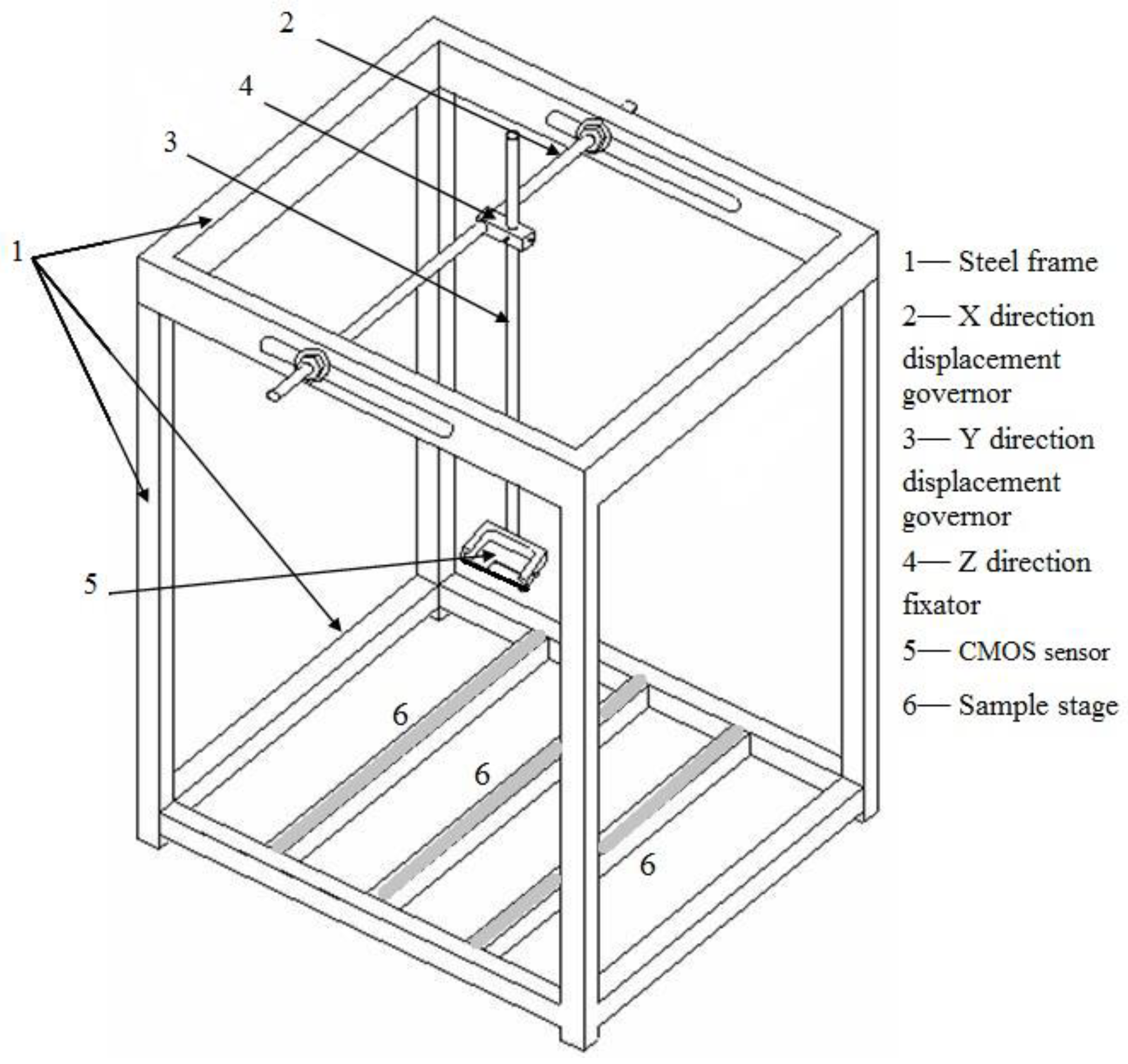
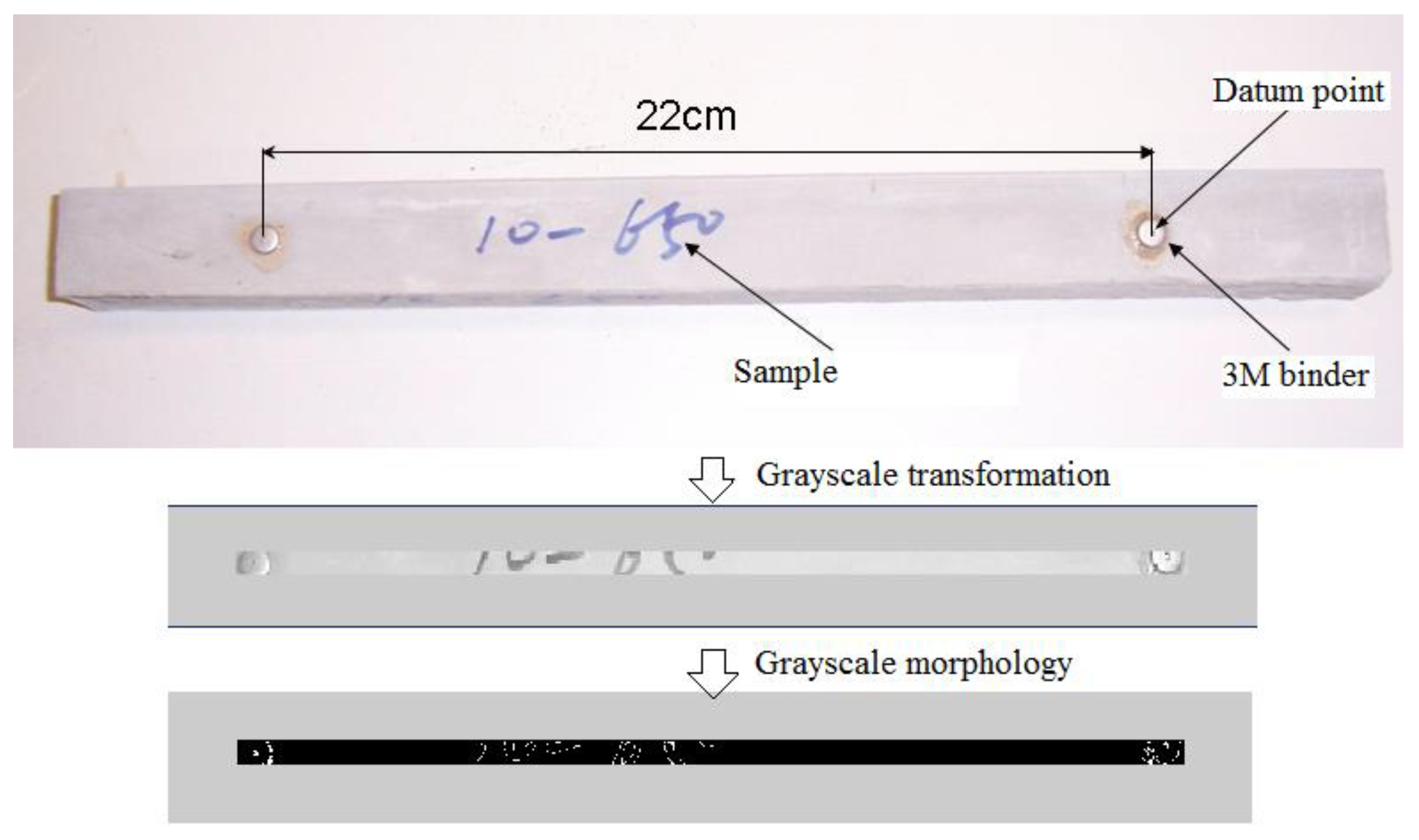
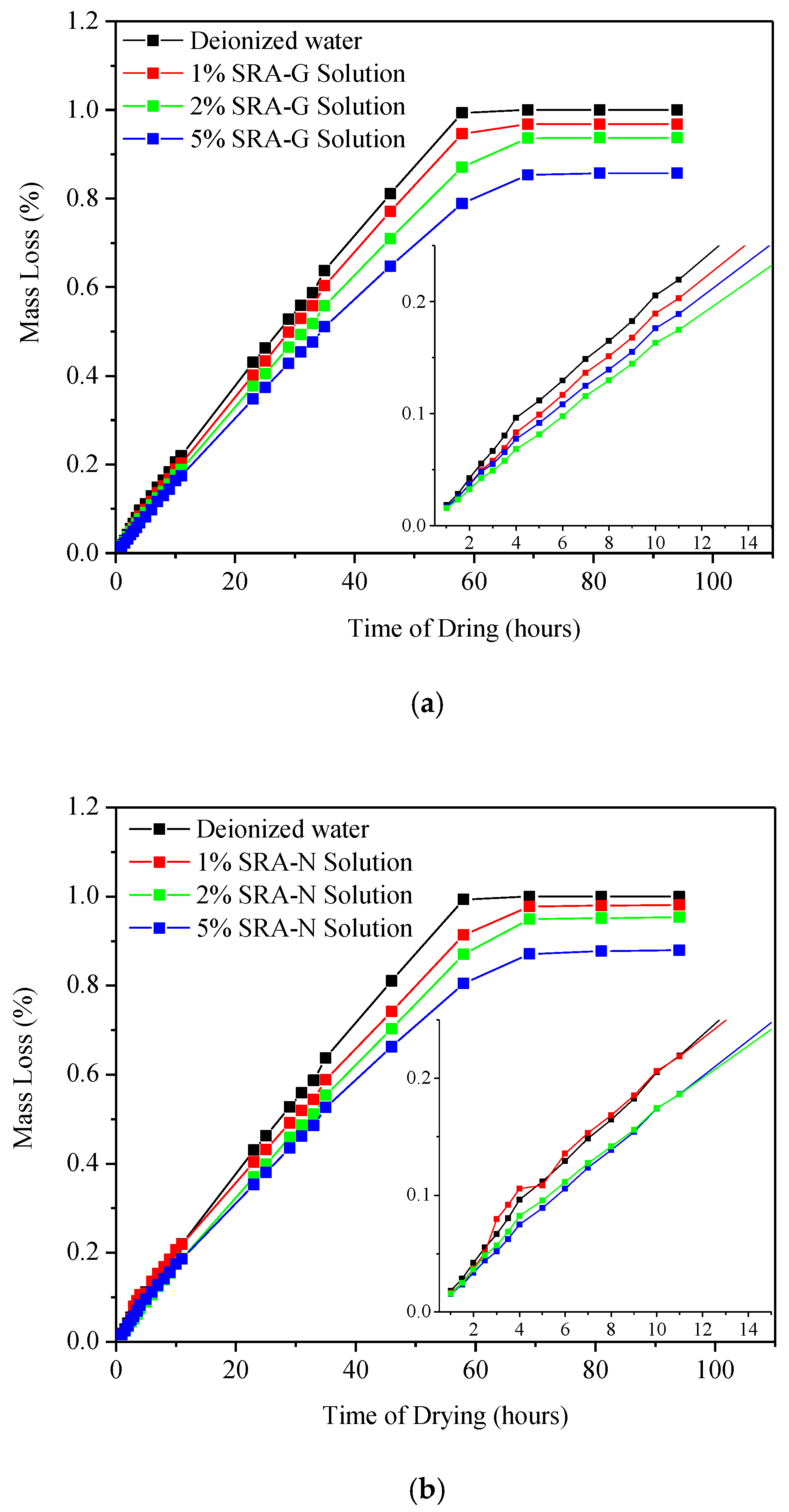
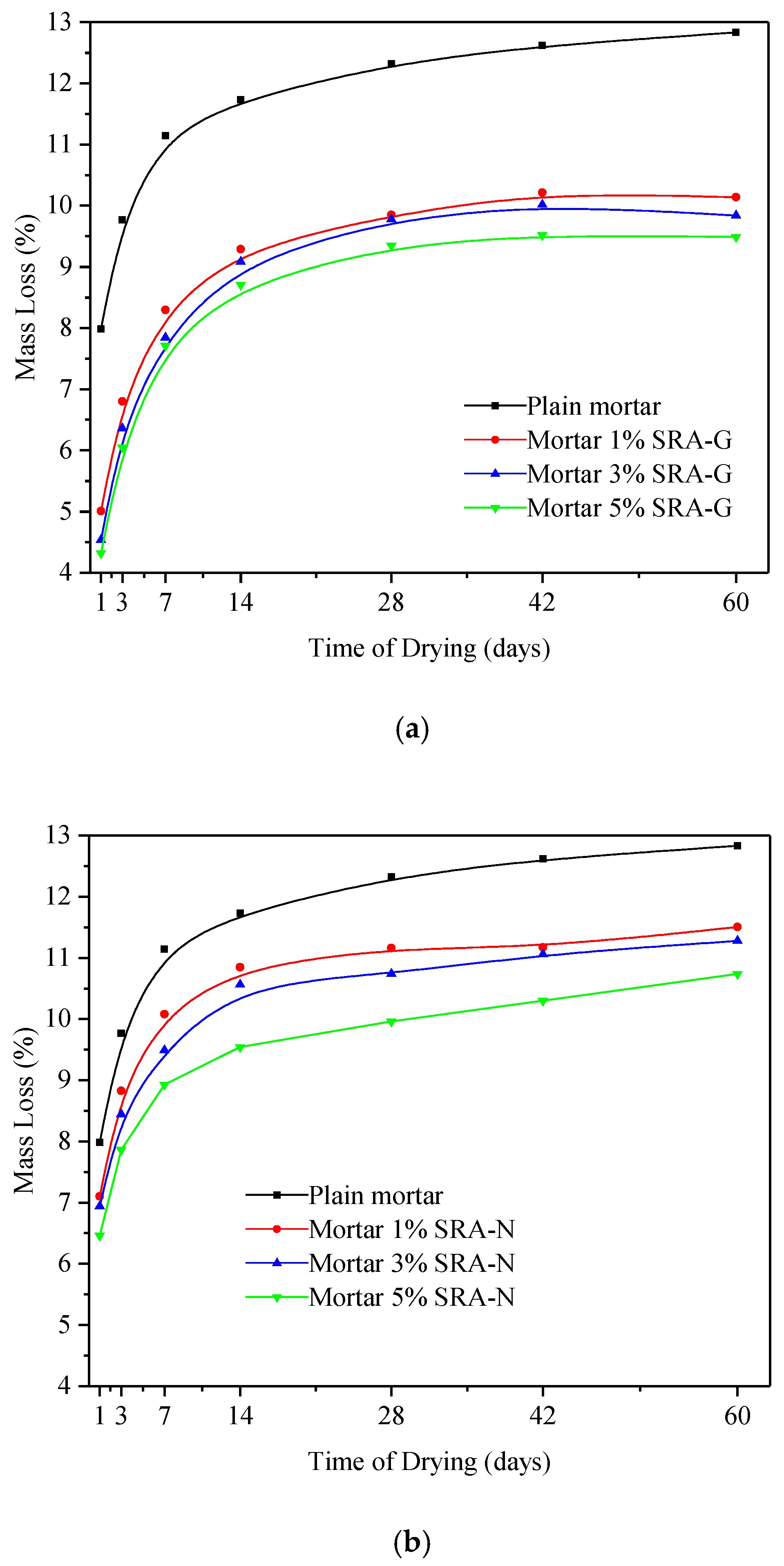
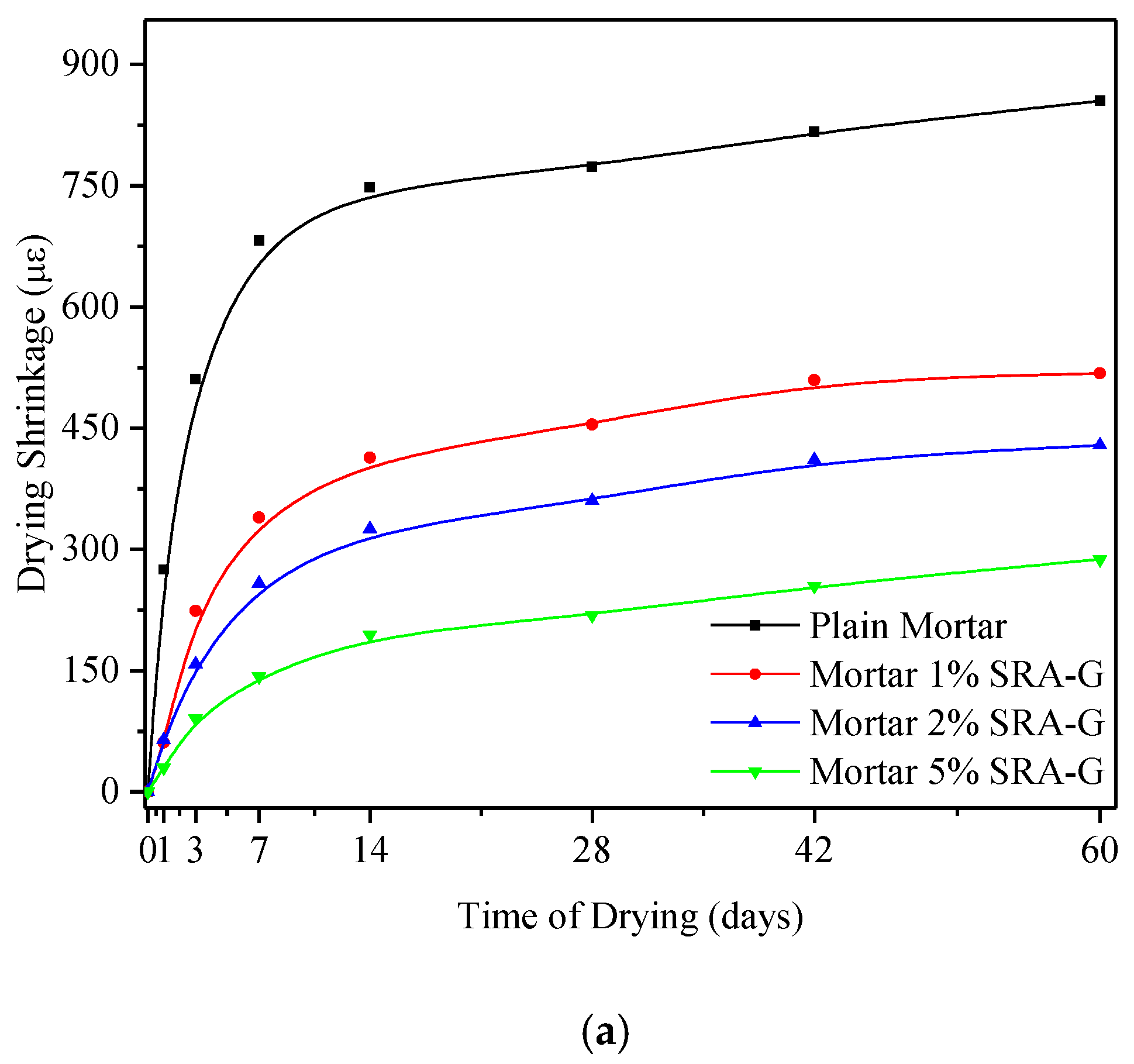
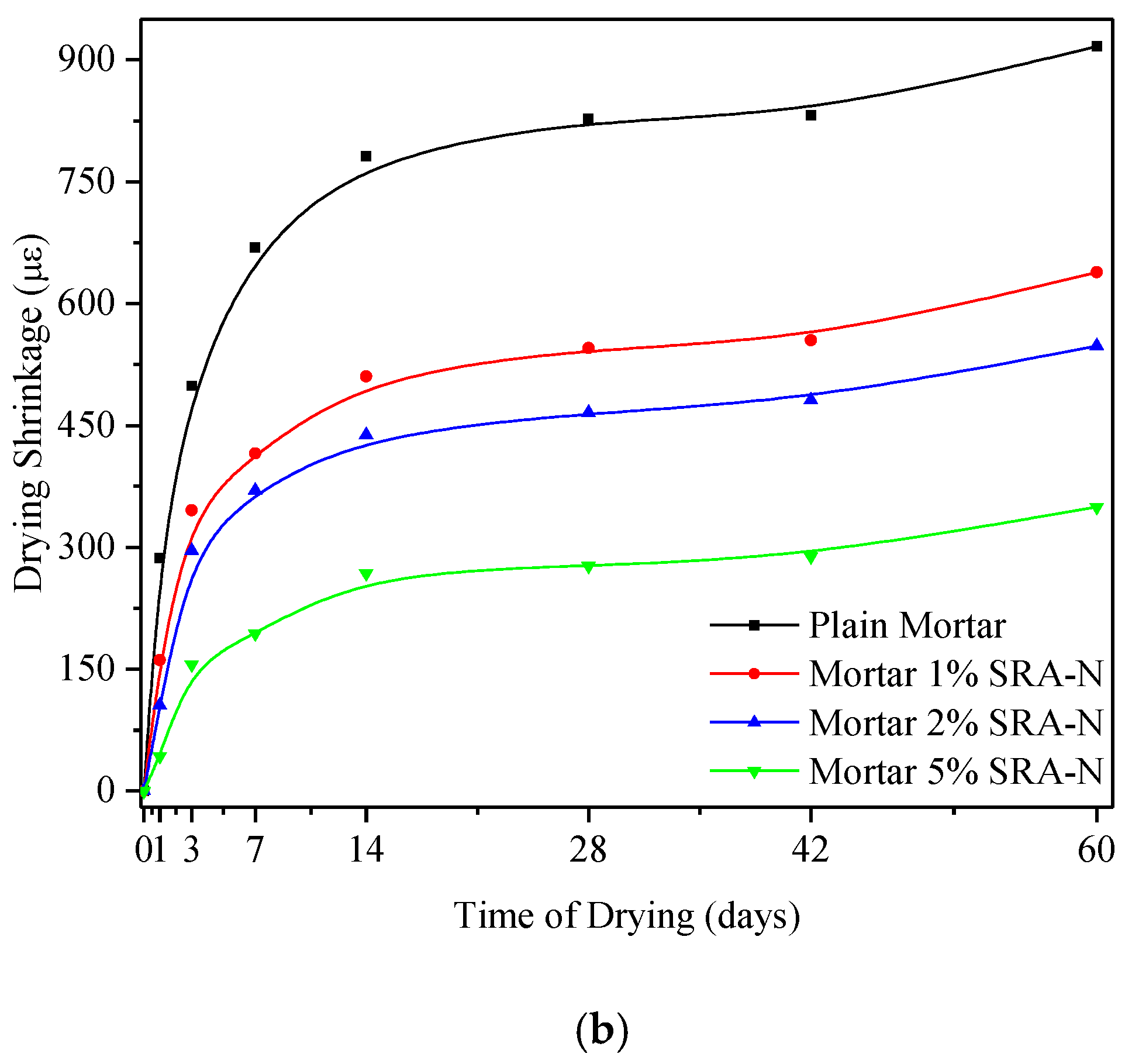
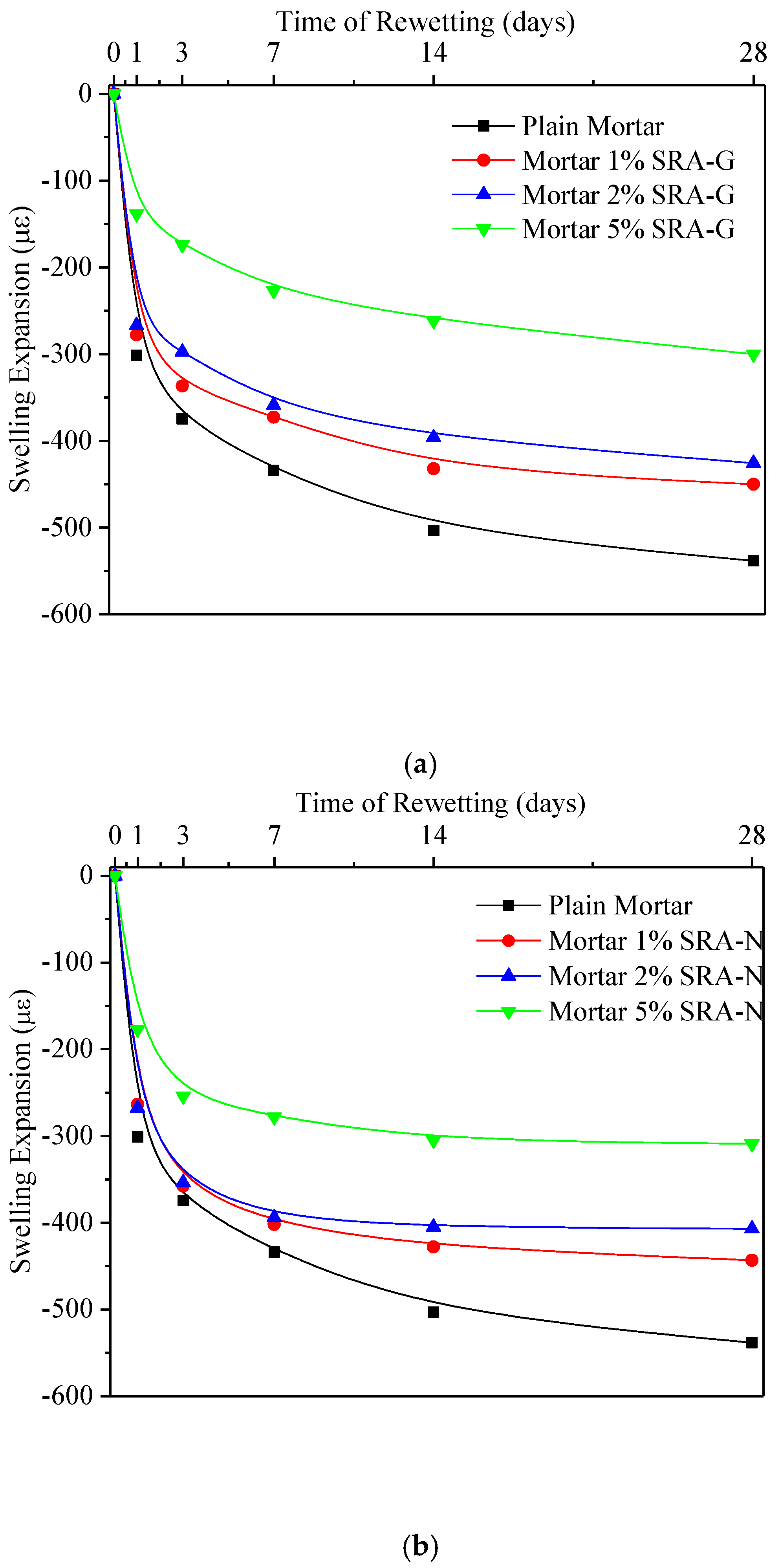
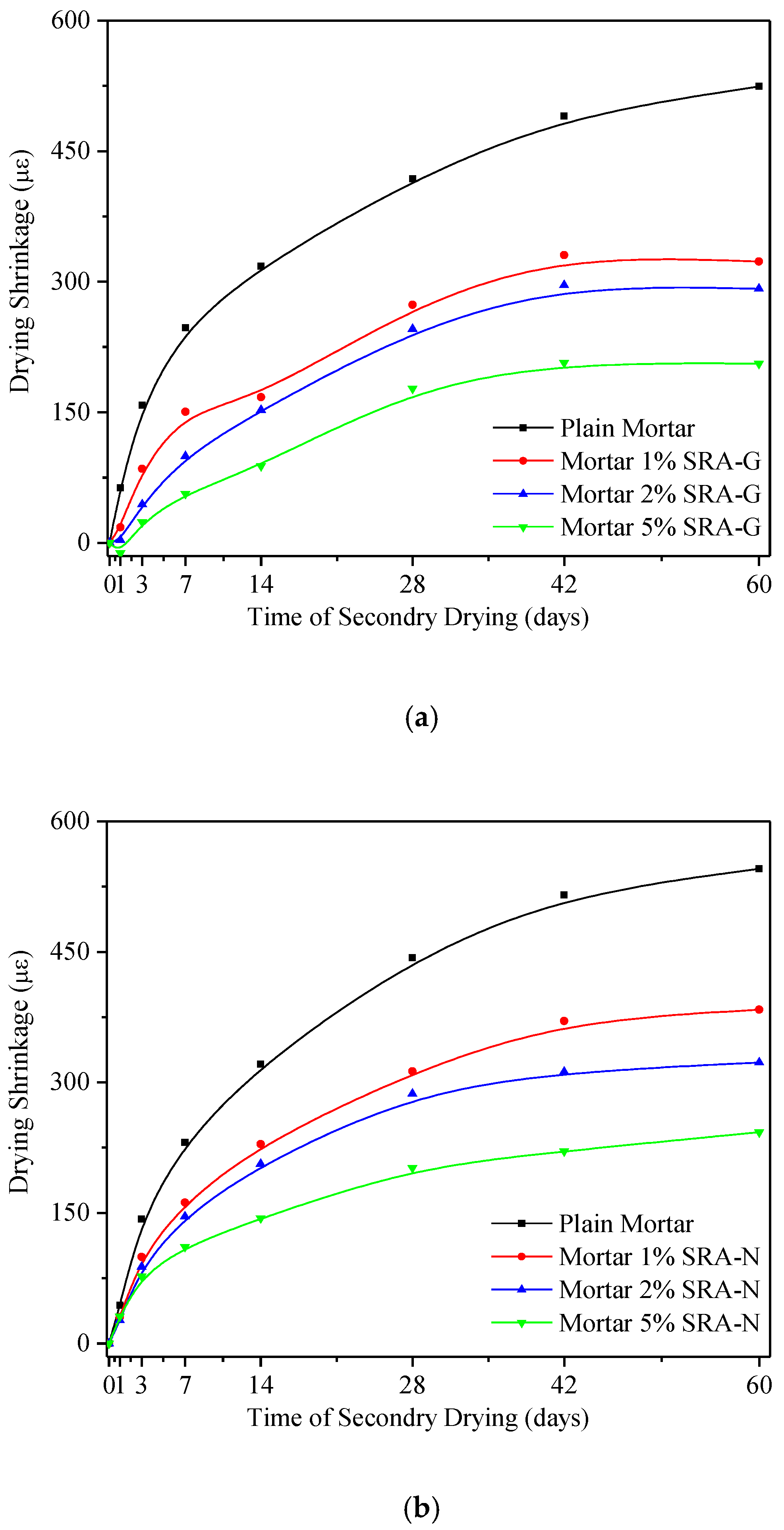
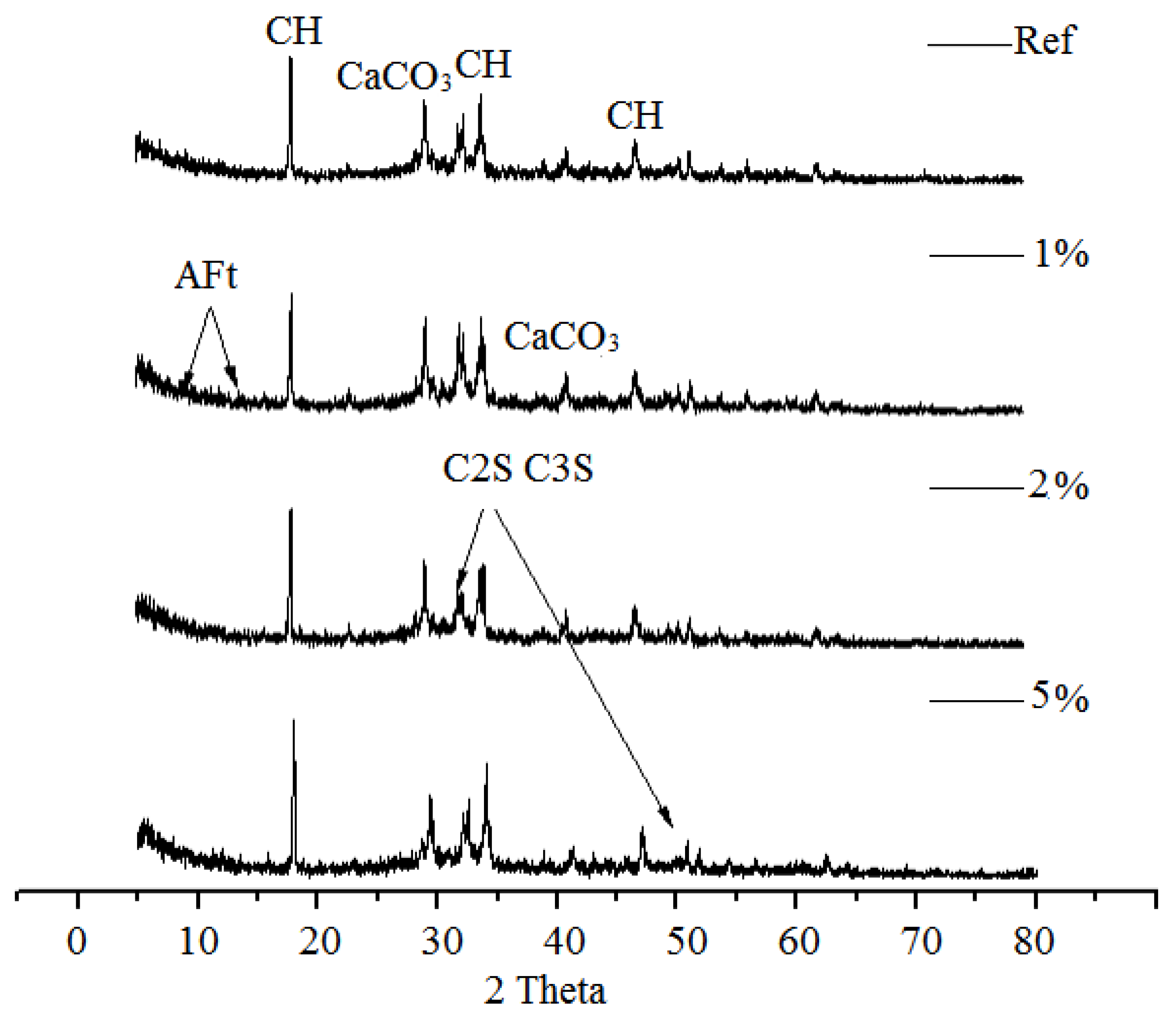
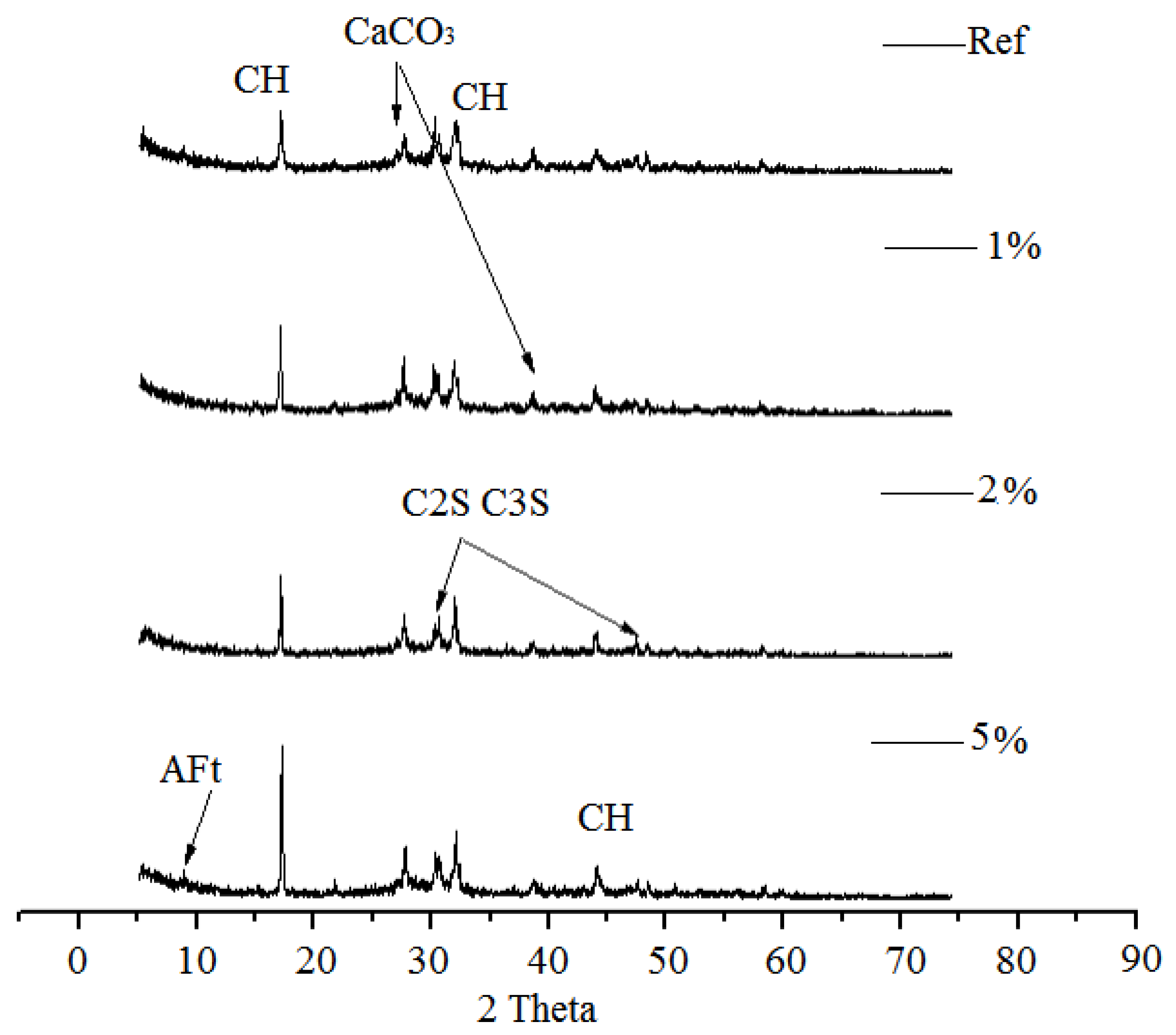
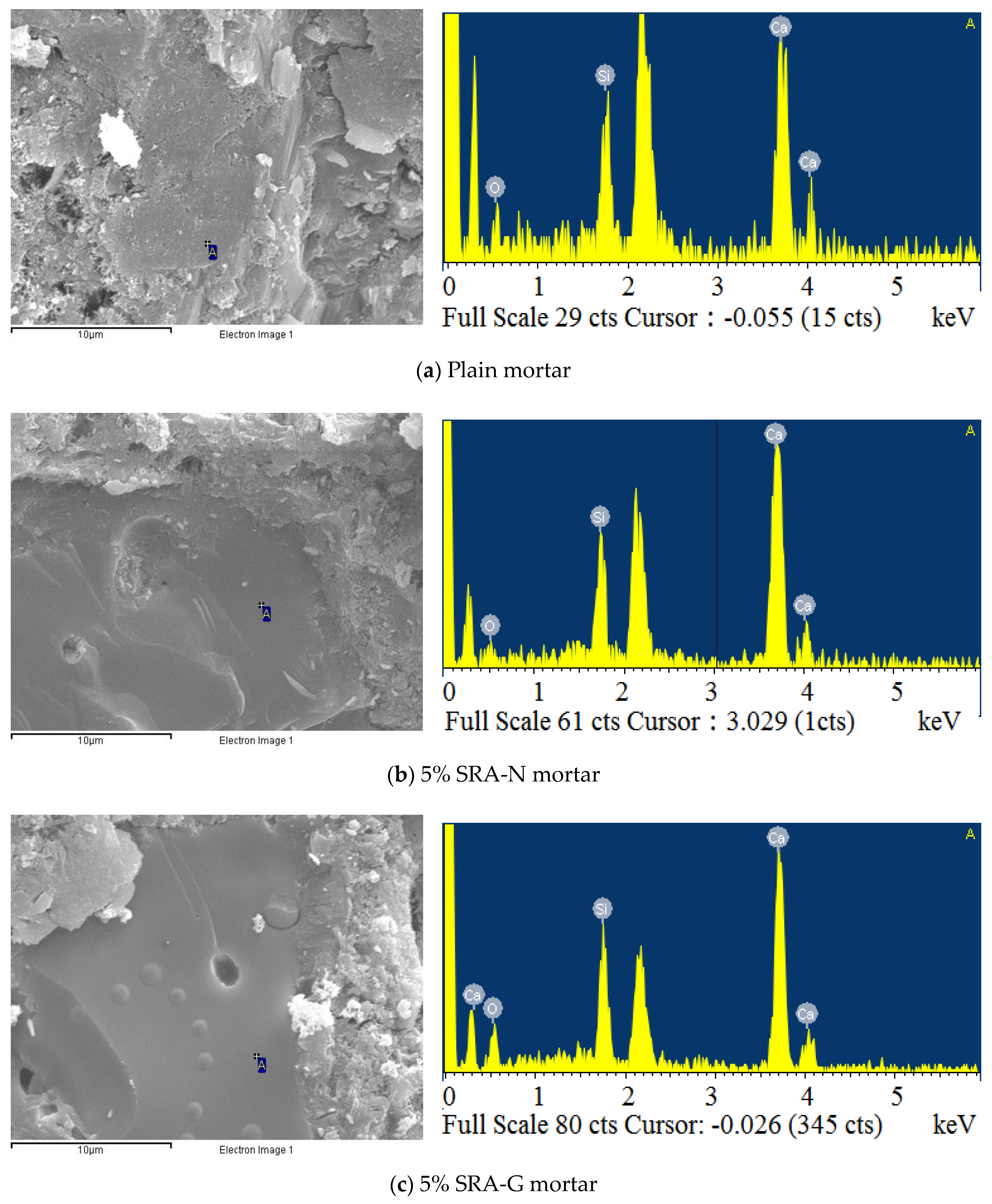
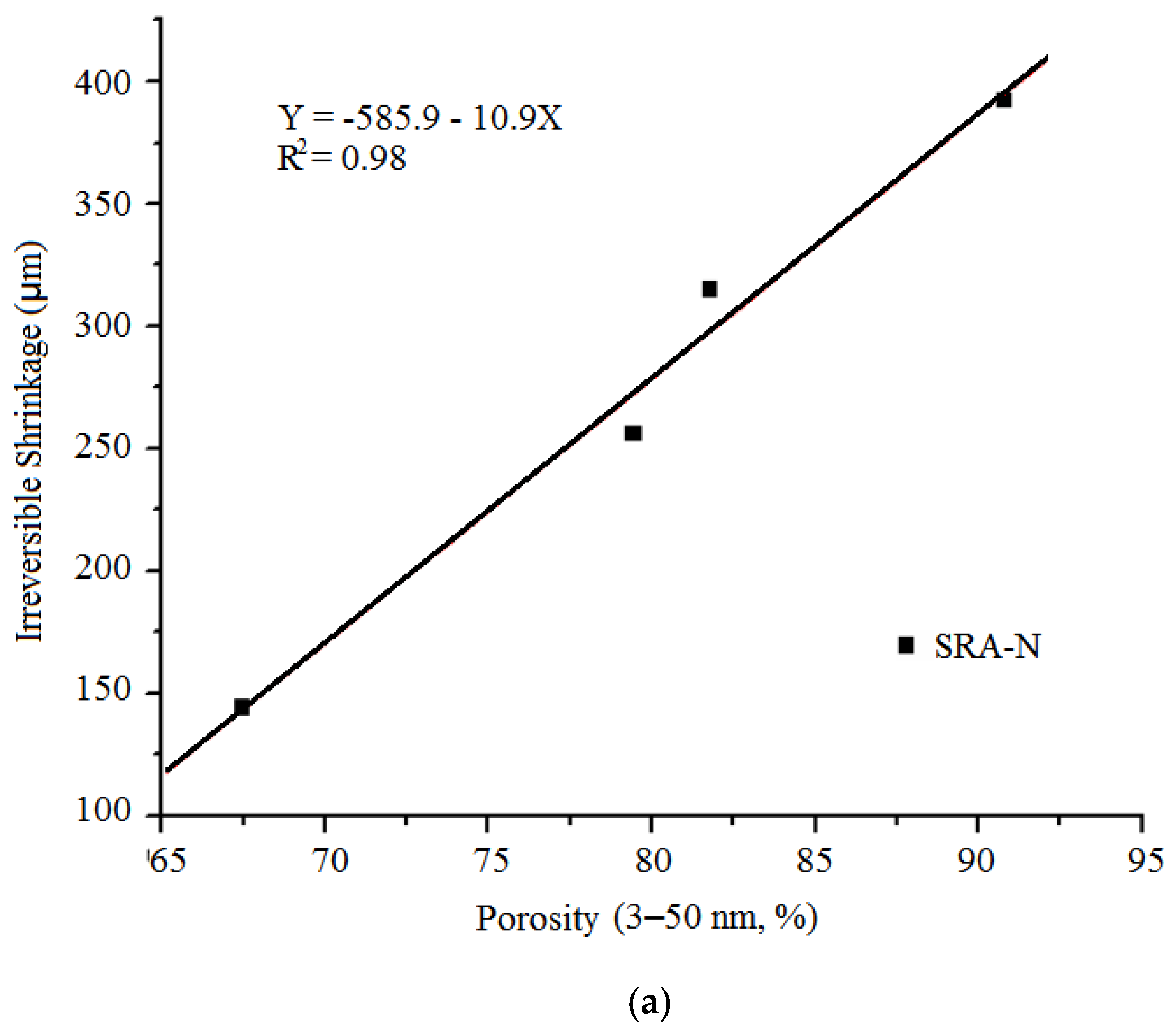
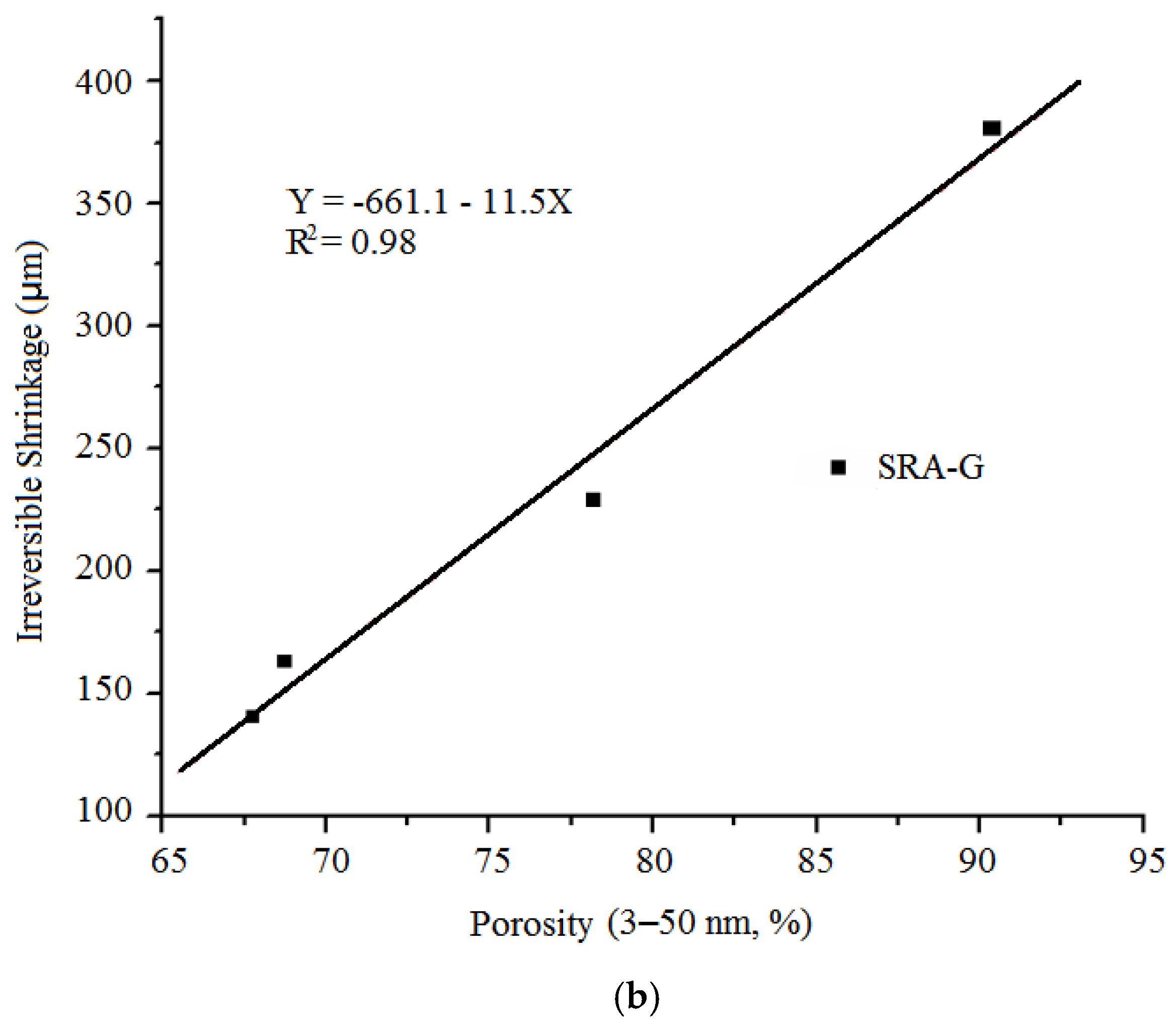

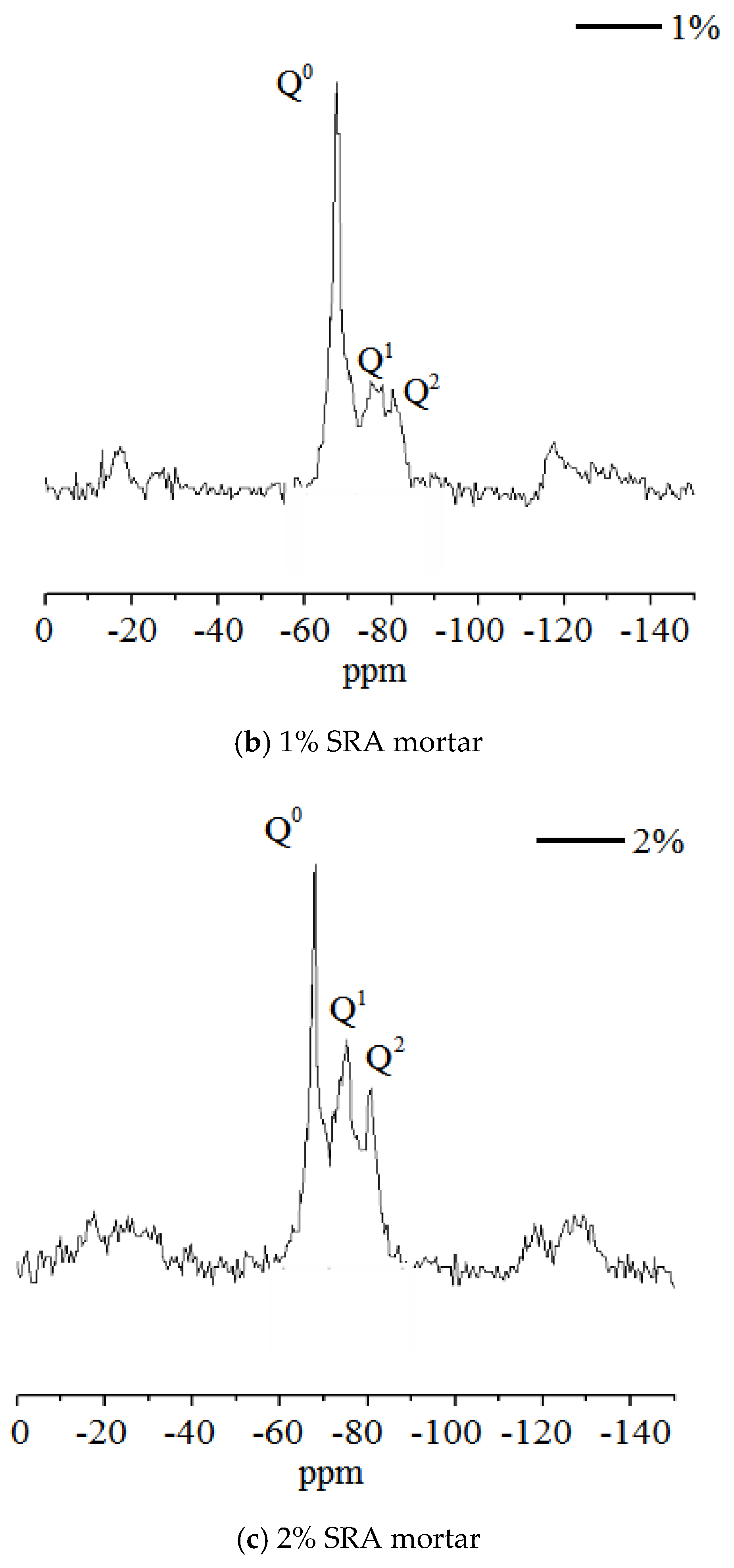
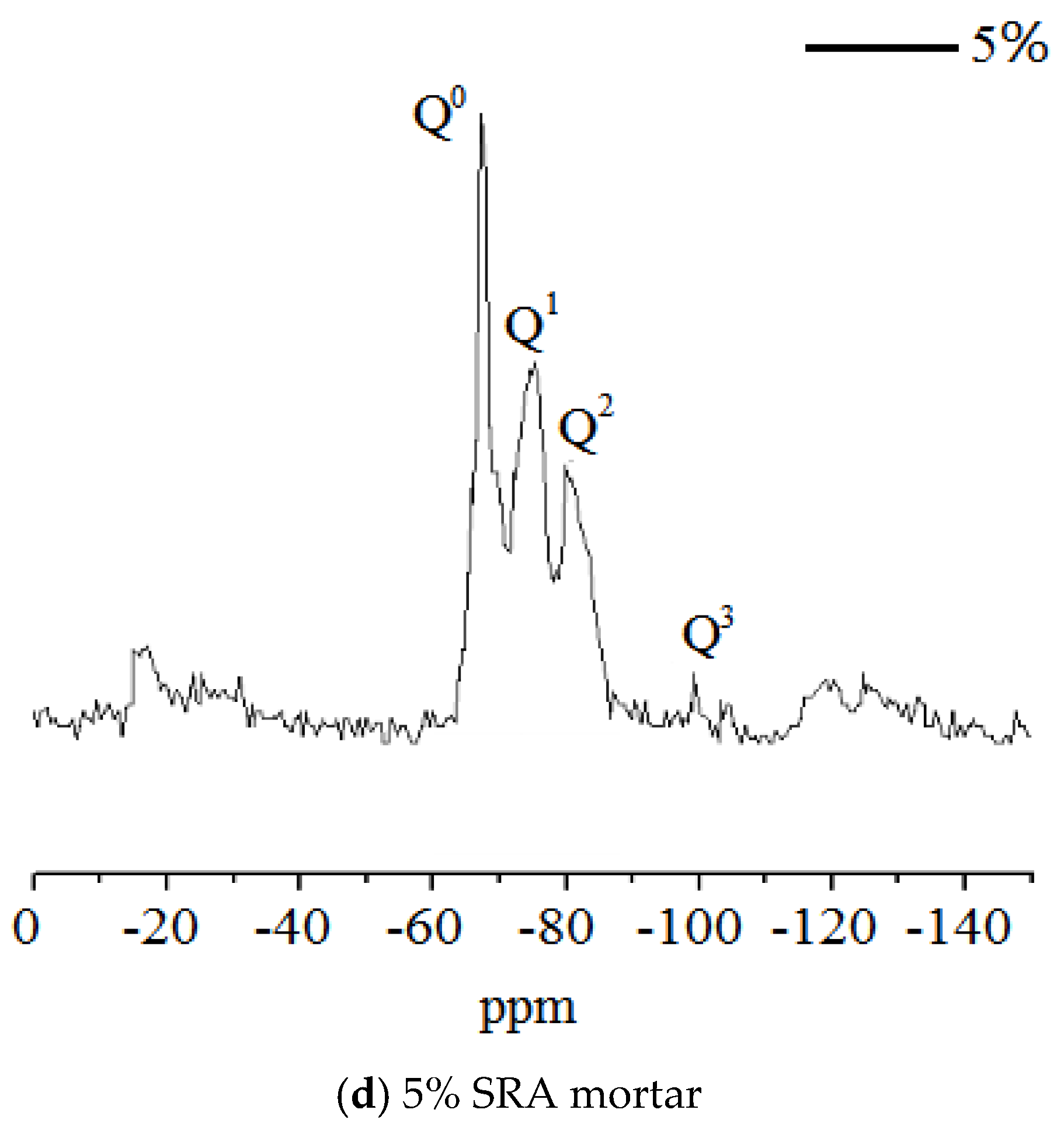
| SiO2 | Al2O3 | Fe2O3 | CaO | MgO | Loss on Ignition | f-CaO | C3S | C2S | C3A | C4AF |
|---|---|---|---|---|---|---|---|---|---|---|
| 21.45 | 4.08 | 2.41 | 63.71 | 2.29 | 1.99 | 0.87 | 58.29 | 21.39 | 7.30 | 6.98 |
| 45 μm Sieve Residual (%) | Blaine Specific Surface Area (m2/kg) | Setting Time (h:min) | Flexural Strength (MPa) | Compressive Strength (MPa) | |||
|---|---|---|---|---|---|---|---|
| Initial Setting | Final Setting | 3 d | 28 d | 3 d | 28 d | ||
| 1.2 | 331 | 3:17 | 4:10 | 5.6 | 9.4 | 28.1 | 57.7 |
| SRA | Molecular Composition | Liquid Appearance | Density (g/mL) | Viscosity (Pa·s) | Surface Tension (mN/m) | Recommended Dosage (wt. %) |
|---|---|---|---|---|---|---|
| SRA-G | Polyether | Light yellow | 1.04 | 100 | 32.5 | 2–3 |
| SRA-N | Polyol | Clear | 1.02 | 50 | 41.7 | 1–2 |
| Number | Cement (kg/m3) | Water (kg/m3) | W/C | Sand (kg/m3) | Additives | |
|---|---|---|---|---|---|---|
| NSP (%) | SRA (%) | |||||
| Ref | 450 | 135 | 0.30 | 1350 | 0.75 | 0 |
| N-1 | 450 | 135 | 0.30 | 1350 | 0.75 | 1 |
| N-2 | 450 | 135 | 0.30 | 1350 | 0.75 | 2 |
| N-5 | 450 | 135 | 0.30 | 1350 | 0.75 | 5 |
| G-1 | 450 | 135 | 0.30 | 1350 | 0.75 | 1 |
| G-2 | 450 | 135 | 0.30 | 1350 | 0.75 | 2 |
| G-5 | 450 | 135 | 0.30 | 1350 | 0.75 | 5 |
| Stage | Primary Drying | Rewetting | Secondary Drying |
|---|---|---|---|
| Condition | |||
| Humidity (%) | 30 | 100 | 30 |
| Temperature (°C) | 35 | 20 | 35 |
| Curing period (days) | 60 | 28 | 60 |
| SRA-G (%) | SRA-N (%) | |||||||
|---|---|---|---|---|---|---|---|---|
| 0 | 1 | 2 | 5 | 0 | 1 | 2 | 5 | |
| Primary drying | 1.00 | 2.01 | 2.64 | 4.77 | 1.00 | 1.61 | 2.49 | 4.38 |
| Secondary drying | 1.00 | 1.43 | 1.81 | 3.45 | 1.00 | 1.24 | 1.64 | 2.19 |
| Plain Mortar (Reference) | 5% SRA-N Mortar | 5% SRA-G Mortar | |||||||
|---|---|---|---|---|---|---|---|---|---|
| wt. % | at. % | Ca/Si | wt. % | at. % | Ca/Si | wt. % | at. % | Ca/Si | |
| Si | 20.48 | 17.40 | 1.4 | 15.96 | 14.02 | 2.1 | 13.73 | 12.26 | 2.6 |
| Ca | 40.16 | 23.90 | 47.06 | 28.97 | 50.48 | 31.61 | |||
| O | 39.36 | 58.70 | 36.97 | 57.01 | 35.79 | 56.13 | |||
| Totals | 100.00 | 100.00 | 100.00 | 100.00 | 100.00 | 100.00 | |||
| Code | Mean Pore Size (nm) | Porosity (%) | Pore Size Distribution (nm) | ||||
|---|---|---|---|---|---|---|---|
| 3–50 | 50–100 | 100–200 | 200–500 | >500 | |||
| Plain mortar | 17.3 | 26.5 | 90.80 | 1.87 | 0.35 | 0.48 | 4.84 |
| N-1 | 18.8 | 23.9 | 81.79 | 5.87 | 0.96 | 1.14 | 5.52 |
| N-2 | 20.8 | 21.0 | 79.46 | 8.70 | 1.02 | 0.74 | 4.16 |
| N-5 | 24.8 | 21.7 | 67.48 | 10.43 | 1.97 | 2.23 | 5.70 |
| G-1 | 17.9 | 25.5 | 76.16 | 6.04 | 0.63 | 0.86 | 5.02 |
| G-2 | 23.8 | 22 | 64.72 | 18.73 | 0.78 | 1.39 | 5.40 |
| G-5 | 24.3 | 20.7 | 63.57 | 20.83 | 0.87 | 1.38 | 4.28 |
© 2020 by the authors. Licensee MDPI, Basel, Switzerland. This article is an open access article distributed under the terms and conditions of the Creative Commons Attribution (CC BY) license (http://creativecommons.org/licenses/by/4.0/).
Share and Cite
Wu, H.; Yao, Y.; Wang, L.; Gao, R.; Lu, S. Monitoring the Whole Cycle Length Change of Cement Mortar Incorporated with SRA by CMOS Image Sensor. Sensors 2020, 20, 468. https://doi.org/10.3390/s20020468
Wu H, Yao Y, Wang L, Gao R, Lu S. Monitoring the Whole Cycle Length Change of Cement Mortar Incorporated with SRA by CMOS Image Sensor. Sensors. 2020; 20(2):468. https://doi.org/10.3390/s20020468
Chicago/Turabian StyleWu, Hao, Yan Yao, Ling Wang, Ruijun Gao, and Shuang Lu. 2020. "Monitoring the Whole Cycle Length Change of Cement Mortar Incorporated with SRA by CMOS Image Sensor" Sensors 20, no. 2: 468. https://doi.org/10.3390/s20020468
APA StyleWu, H., Yao, Y., Wang, L., Gao, R., & Lu, S. (2020). Monitoring the Whole Cycle Length Change of Cement Mortar Incorporated with SRA by CMOS Image Sensor. Sensors, 20(2), 468. https://doi.org/10.3390/s20020468






